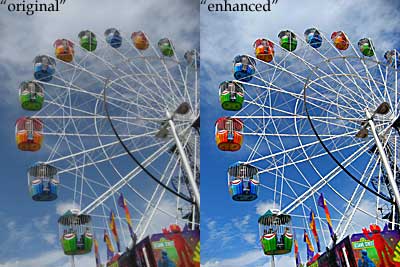Post processing digital images - right or wrong?
There is an ongoing debate in the world of photography over whether photos should be post processed. In other words, should image editing software be used to alter the image that came from the camera; or should the image be left alone as an unaltered record of the scene?
First of all there are two types of post processing available to the digital photographer:
Image manipulation: Image manipulation can include things like removing the drainpipe that is coming out of your daughter's ear from a graduation photo, to making a model appear to have completely flawless skin. This is clearly altering what was originally in the scene when it was shot. And whether this constitutes a breach of the photographic rules depends on your point of view. If you are creating a picture, in the way an artist creates a work of art, then it would seem perfectly acceptable. After all, we wouldn't expect a pencil artist to be without an eraser in his or her pencil box. As the art work begins to take shape an artist will constantly adjust their work by adding or taking away elements of the picture in order to make it perfect. In which case, why should a photographer employing the same process of adding-in or taking-away be criticised for doing so? Simply because they use software to make their changes shouldn't make a difference. The artists' toolbox is pencils, brushes and erasers, the photographers toolbox is software. If on the other hand a photographer intends to record a scene 'as is' then manipulating like this moves the photographer into the world of deception. Image enhancement: Image enhancement is another matter altogether. Image enhancement takes the image 'as is' and them makes it a better representation of the original. Many photographers wrongly assume that image enhancement is a product of digital photography. And that in the days of film photography this sort of enhancement just didn't happen. It did happen. A lot. The only difference was that you needed a darkroom, chemicals, filters, masks . . . and a plethora of other equipment in order to enhance your images. Today the same set of tools required can be bought quite cheaply, is available to all and is called software. Take image sharpening as an example. Most image editing software includes a 'sharpen' tool. And more sophisticated software also includes an 'unsharp mask' tool. The origins of image sharpening using the unsharp mask tool lie in 1930s Germany, not in 1990s Photoshop. In the 1930s no-one called the photographers of the day who used this technique frauds. They were admired for their ability to make images appear pin sharp. So why should a digital photographer be accused of image manipulation for making his or her images sharp? Take contrast and saturation as further examples. In the days of film photographers adjusted the timings of chemical saturation in order to produce more saturated photos. And a similar technique could improve image contrast. Make the same adjustments with digital photography and the fraud label begins to rear its ugly head once more. Take this one step further - back in the days of film photography, certain film manufacturers were known to produce films that had better contrast and colour saturation. Velvia is a particular one that springs to mind. So if you used Velvia film were you cheating? The camera as villan As a final point, a lot of digital photographers are unaware that the photo they have taken has almost always been enhanced by the camera itself, even before the image has been displayed on the LCD screen. Digital cameras, especially pocket versions, save images as JPEGs. To do this the camera takes the raw image data from the image sensor, and then uses built-in software to turn that data into a photo. The software is programmed to give the image good colour tone and sharpens it a bit. On some digital cameras you have to option to increase or decrease the level of enhancement the camera does to your photos. A lot of people just leave it at the default. So straight away the photo you took has been enhanced using software. But I can hear digital SLR photographers mumbling about 'RAW' images. Surely these haven't been enhanced? Oh yes they have. But not directly. The RAW image is the data straight from the image sensor with absolutely no adjustments made by the camera. But in order to view these RAW images you need to use software to convert the RAW data into a viewable photo - and instantly you have added software adjustments. You have the option of playing with the contrast, brightness, sharpness . . . and a whole host of other settings. But by doing so you have now altered your original photo. My closing points - don't be fooled into thinking image manipulation or enhancement are a product of the digital age; and remember that your camera is making adjustments even before you see the photo so don't assume that the photo you took is completely un-adjusted. Darrell. |
Comments for Post processing digital images - right or wrong?
|
||
|
||
|
||
|
||
|
||
|
||
|
||
|
||
|
||
|
||
|
||
|
Click here to add your own comments Join in and write your own page! It's easy to do. How? Simply click here to return to Articles. |

